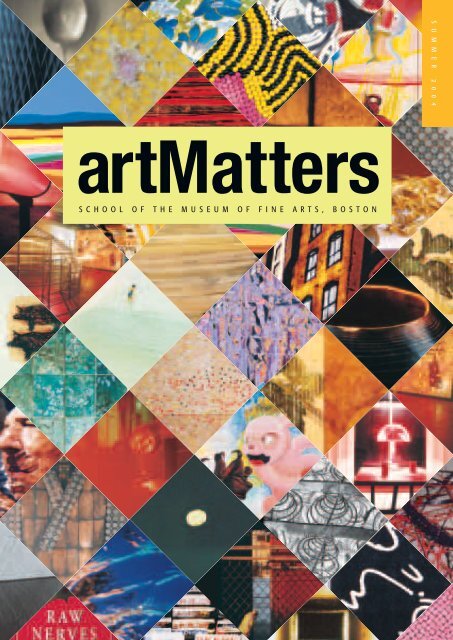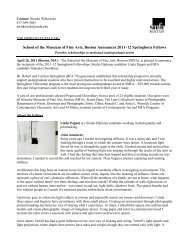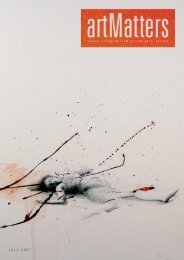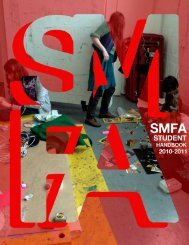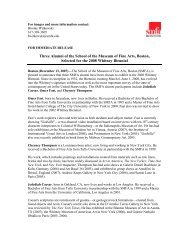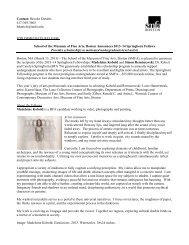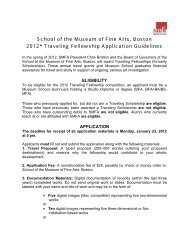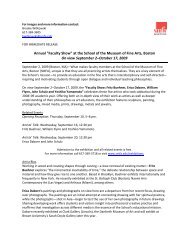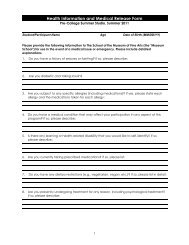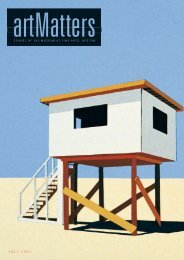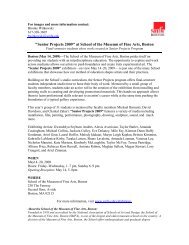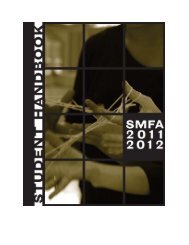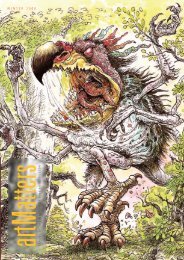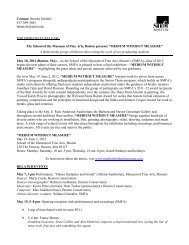School of the Museum of Fine Arts, Boston
School of the Museum of Fine Arts, Boston
School of the Museum of Fine Arts, Boston
You also want an ePaper? Increase the reach of your titles
YUMPU automatically turns print PDFs into web optimized ePapers that Google loves.
SCHOOL OF THE MU S E U M O F F I N E A R TS, BOSTON<br />
S U M M E R 2 0 0 4
PHOTO: TONY RINALDO<br />
DEAR ALUMNI AND FRIENDS,<br />
The <strong>Museum</strong> <strong>School</strong> challenged you to find new and different<br />
ways to make art, to embrace a range <strong>of</strong> media and create<br />
something highly personal. The classes you chose shaped<br />
an education and experience unique to you, making your<br />
art distinctive.<br />
This freedom to design your process <strong>of</strong> art making lies at <strong>the</strong><br />
heart <strong>of</strong> <strong>the</strong> <strong>Museum</strong> <strong>School</strong> philosophy and educational<br />
strength. It is evident in <strong>the</strong> images and comments alumni<br />
have contributed to <strong>the</strong> following pages.<br />
You’ll find Marilyn Monroe’s portrait, a can <strong>of</strong> Jeffuschewitz<br />
Eyeballs, and a taste <strong>of</strong> Tuscany. The media include M&Ms,<br />
shoelaces, pom-poms, tissue paper, paint, silver, wood, film,<br />
and a hotel bed.<br />
This collection represents but a small slice <strong>of</strong> alumni artwork.<br />
Yet <strong>the</strong> images speak to your boundless zeal for art making.<br />
The accompanying statements come from <strong>the</strong> artists’ own<br />
words. Whe<strong>the</strong>r describing <strong>the</strong> process <strong>of</strong> art making or <strong>the</strong><br />
choice <strong>of</strong> materials, each voice provides background, insight,<br />
and valuable information.<br />
We are delighted to present this second all-art issue <strong>of</strong><br />
artMatters. We think it highlights <strong>the</strong> accomplishments<br />
<strong>of</strong> our alumni and illustrates <strong>the</strong> range <strong>of</strong> expression that<br />
derives from <strong>the</strong> freedom to think about and create art.<br />
Please use <strong>the</strong> reply card on <strong>the</strong> back to tell us how <strong>the</strong><br />
<strong>Museum</strong> <strong>School</strong>’s philosophy <strong>of</strong> education helped shape<br />
your life as an artist or observer <strong>of</strong> art. Your comments<br />
help us expand <strong>the</strong> reach and direction <strong>of</strong> art making.<br />
West Street, 2004. Stained-glass panel, 11 x 13 feet<br />
NANCY NICHOLSON DIPLOMA, 1985<br />
The intricacy <strong>of</strong> shapes created by buildings nested<br />
toge<strong>the</strong>r attracts me. Light and colors constantly<br />
change while <strong>the</strong> structures remain solid and still. I<br />
portray <strong>the</strong> nuances <strong>of</strong> light as it passes through <strong>the</strong><br />
buildings or reflects <strong>of</strong>f <strong>the</strong>m; how shadows occur<br />
over <strong>the</strong> textures <strong>of</strong> glass, brick, and concrete, and<br />
<strong>the</strong> wonderful cut-out shapes <strong>of</strong> <strong>the</strong> sky. Glass and<br />
lead reflect <strong>the</strong> elements in <strong>the</strong> urban environment.<br />
Editor’s note: The following statements are based<br />
on <strong>the</strong> artist’s own words and reflect <strong>the</strong> tone,<br />
thoughts, and personal insight he or she submitted<br />
to artMatters.<br />
DEBORAH H. DLUHY<br />
DEAN, MUSEUM SCHOOL<br />
DEPUTY DIRECTOR, MUSEUM OF FINE ARTS, BOSTON
B O N N I E M I N E O<br />
“ Colors are <strong>of</strong>ten <strong>the</strong> starting point.”<br />
marilyn mmosaic, 2003. M&Ms candy in twenty-one colors glued on<br />
monochromatic green/silver acrylic painting on canvas mounted on<br />
board, 42 x 42 inches<br />
THOMAS STOCKER DIPLOMA, 1966<br />
Since my childhood in <strong>the</strong> early 1950s I associated<br />
Marilyn Monroe with M&Ms candy. The medium is a<br />
metaphor for her life and death—her overdose on<br />
pills. After seeing <strong>the</strong> enormous mosaic faces <strong>of</strong> <strong>the</strong><br />
saints looking down from <strong>the</strong> dome <strong>of</strong> <strong>the</strong> Ca<strong>the</strong>dral<br />
<strong>of</strong> Hagia Sophia in Istanbul last year, I returned to<br />
<strong>Boston</strong> and created this homage.<br />
SMFA.EDU 1
Pod Table Lamp, 2004. Paper, twigs, stone, electrical parts, 21 x 9 x 8 inches<br />
KATHERINE AHERN ATTENDED 1989<br />
The visual qualities and emotional content <strong>of</strong> natural light<br />
captivate me. I explore ways <strong>of</strong> bringing <strong>the</strong> peaceful and<br />
regenerating qualities <strong>of</strong> natural materials and light indoors.<br />
The sculptural component <strong>of</strong> my work relies on <strong>the</strong> iconic<br />
forms <strong>of</strong> nets, stone piles, and forests. My work is about<br />
simplicity, integration, and well-being.<br />
2
Untitled, 2001. Carborundum and monotype, 7 x 7 inches<br />
LAURA TANGUSSO D IPLOMA, 1996<br />
I am concerned with <strong>the</strong> tactile qualities evoked by ink,<br />
paper, and <strong>the</strong> particular printing method. The techniques<br />
I use—drypoint, monotype, and/or carborundum printing<br />
on s<strong>of</strong>t aluminum plates—yield subtle shadings and<br />
imperfections that allude to <strong>the</strong> human presence and<br />
process. I work with a few elements in <strong>the</strong> effort to create<br />
depth and character with focused, spare forms. Wheels or<br />
circles suggest continuity, balance, unity, and life cycles.<br />
Tuscan Vineyard, 2002. Mixed media on wood, 18 x 18 x 2 inches<br />
BONNIE MINEO BACHELOR OF FINE ARTS, 1996;<br />
D IPLOMA 1998<br />
Colors are <strong>of</strong>ten <strong>the</strong> starting point. The Tuscan landscape<br />
inspired a series <strong>of</strong> warm, vibrant responses to a place from<br />
ano<strong>the</strong>r time. Only <strong>the</strong> smallest fragment exists—a leaf or<br />
branch, an architectural detail, or shapes suggested by<br />
nature. These <strong>of</strong>ten-overlooked details become <strong>the</strong> subject<br />
<strong>of</strong> a painting that contains layers <strong>of</strong> paper and paint,<br />
gestures, and shapes, searching for <strong>the</strong> quiet reflection <strong>of</strong> a<br />
place and a moment in time.<br />
Untitled, 2003. Enamel on aluminum, 10 x 10 3 ⁄8 inches<br />
HENRY SAMELSON POST-BACCALAUREATE<br />
CERTIFICATE, 2000; MASTER OF FINE ARTS, 2003<br />
My paintings are battlegrounds. I <strong>of</strong>ten think, as a cartoon<br />
character might, about relationships between physics and<br />
meaning. Ultimately, my work returns to <strong>the</strong> complicated,<br />
contradictory simplicity <strong>of</strong> wondering where I am and where<br />
<strong>the</strong> planet that I am <strong>the</strong>oretically attached to is located.<br />
SMFA.EDU 3
One Night in Nineteen Seventy, 2003. Two LCD monitors, bed, audio<br />
speakers, dimensions variable<br />
JAMES NADEAU BACHELOR OF FINE ARTS, 2001<br />
Each artist in <strong>the</strong> “Paradise Hotel” installation transformed<br />
a hotel room. My room was completely dark except for <strong>the</strong><br />
glow from <strong>the</strong> monitors. The audio was <strong>the</strong> number one<br />
song in 1970, They Long to Be (Close to You) by <strong>the</strong><br />
Carpenters, and <strong>the</strong> video was a gay male pornographic<br />
film from 1970 that viewers could see only by lying on<br />
<strong>the</strong>ir stomachs on <strong>the</strong> bed. They were forced to interact<br />
with this piece by lying on <strong>the</strong> bed as if sexually available.<br />
I complicated <strong>the</strong> piece by screening scenes <strong>of</strong> unsafe sex,<br />
historicizing it as pre-AIDS in a seemingly less-complicated<br />
time. I am interested in <strong>the</strong> ways queer culture and, to an<br />
extent, o<strong>the</strong>r “minority” cultures are forced to construct<br />
histories for ourselves from <strong>the</strong> bits and pieces we salvage<br />
as outsiders.<br />
Ben, 2002. Gouache on board, 12 x 11 inches<br />
LAURA CHASMAN DIPLOMA, 1969; FIFTH<br />
YEAR CERTIFICATE, 1970<br />
The desire to paint someone’s portrait is about my wish to<br />
hold on to <strong>the</strong> experience <strong>of</strong> that individual—<strong>the</strong> physical<br />
and <strong>the</strong> emotional. Notice <strong>the</strong> poetic, <strong>the</strong> odd, <strong>the</strong> beauty in<br />
<strong>the</strong> unplanned presentation <strong>of</strong> oneself, <strong>of</strong> just simply being.<br />
A Few (Starry) Personages, 2003. 4,800 pom-poms glued to Plexiglas<br />
installed in front windows, translated from a portion <strong>of</strong> an image captured<br />
from <strong>the</strong> Edison Hotel Web cam, South Beach, Miami, “Beach Augury”<br />
exhibition, Art Basel Miami Beach 2003<br />
WILL PAPPENHEIMER MASTER OF FINE<br />
ARTS, 1997<br />
We drew a rectangle on <strong>the</strong> Edison Hotel Web cam image<br />
and watched beach-goers pass through. These images<br />
were <strong>the</strong>n marked by poms, enlarged into “pixel” poms,<br />
and disseminated throughout <strong>the</strong> world. They became a<br />
contemporary version <strong>of</strong> a prediction, an omen, or an<br />
augury “reading,” <strong>the</strong> ancient practice <strong>of</strong> setting out a<br />
rectangle and scrutinizing it for a particular period <strong>of</strong> time<br />
to count <strong>the</strong> number <strong>of</strong> stars, birds, etc., that pass through.<br />
4
Pool Study No. 33, 2003. C-print, mounted on aluminum, black sintra, and<br />
acrylic, 31 x 48 inches<br />
EMILY G. KAHN D IPLOMA, 1998; FIFTH YEAR<br />
CERTIFICATE, 1999<br />
I am a daily lap swimmer, with my face in <strong>the</strong> water for<br />
1 1 ⁄2 to 2 hours. This print is an exploration. With <strong>the</strong> camera<br />
lens partially in water I catch a very abstract look as well as<br />
sharpness in some <strong>of</strong> <strong>the</strong> image. When a stranger walked<br />
into my studio and said, “This is exactly how it looks,” I felt<br />
affirmed. It turned out that she, too, is a lap swimmer.<br />
Specimen #jf021904 (detail), 2004. Hot-melt glue, shrink wrap, polyester fiber,<br />
metal findings, acrylic paint, shellac, 4 x 3 x 11 inches<br />
BRIAN BURKHARDT D IPLOMA, 2003; FIFTH<br />
YEAR CERTIFICATE, 2004<br />
After working on a large commercial farm that used pesticides,<br />
insecticides, and genetically modified seeds, I migrated to a<br />
small organic farm. There, I spent most <strong>of</strong> my time on my<br />
hands and knees pulling weeds and collecting beetles in a<br />
c<strong>of</strong>fee can. The farms reflect <strong>the</strong> history <strong>of</strong> conflicting feelings<br />
we have about our environment: We want to preserve nature<br />
and to control it. In my fabricated world I display <strong>the</strong><br />
“scientific evidence” <strong>of</strong> <strong>the</strong> changes we make.<br />
SMFA.EDU 5
Untitled 1, 2002. Selenium-toned gelatin silver print, 20 x 24 inches<br />
NICK JOHNSON D IPLOMA, 1978<br />
No darkroom trickery is used in this image. I placed flagstones<br />
in a tray <strong>of</strong> water to create <strong>the</strong> photograph with reflections. The<br />
flagstones are <strong>of</strong>ten cut into shapes, chiseled, and sanded.<br />
I painted all <strong>of</strong> <strong>the</strong> stones to remove color variations that can<br />
be distracting in <strong>the</strong> final print. The idea to build my subjects<br />
grew out <strong>of</strong> a difficulty finding things to photograph that<br />
looked and felt like what I could see in my mind.<br />
“I search for that bit <strong>of</strong> beauty<br />
6
Tissue (detail), 2003. Installation <strong>of</strong> fourteen figures, black tissue paper,<br />
adhesive, 64 x 15 x 15 inches each<br />
HEATHER COX MASTER OF FINE ARTS, 1998<br />
Each figure echoes <strong>the</strong> silhouette <strong>of</strong> my body. When<br />
viewers wander among <strong>the</strong> 3-D shadows <strong>the</strong>y generate<br />
air currents that gently turn <strong>the</strong> hanging figures. The<br />
forms are reminiscent <strong>of</strong> tissue-paper party decorations<br />
gone seriously awry.<br />
in <strong>the</strong> most ordinary <strong>of</strong> details.”<br />
Atwater, 1998. Giclee print, 16 x 20 inches<br />
JOHN GOUGH BACHELOR OF FINE ARTS, 1990<br />
The photographs in this series explore Los Angeles<br />
through its unique light, terrain, and architecture. I hope<br />
to convey a sense <strong>of</strong> <strong>the</strong> psychology and history that give<br />
people a feeling <strong>of</strong> place.<br />
E U G E N I E L E W A L S K I B E R G<br />
SMFA.EDU 7
Black Baskets, 2003. Scorched madrone burl, 1 to 12 inches<br />
CHRISTIAN BURCHARD D IPLOMA, 1981<br />
Pacific madrone burl changes as it dries, forcing me to step back from my work<br />
and relinquish control for a short time while letting <strong>the</strong> wood find its own shape. My<br />
objects tell stories. They are highly unlikely, with a life <strong>of</strong> <strong>the</strong>ir own. They give glimpses<br />
<strong>of</strong> possibilities or act as metaphors, serving as a transport for ideas and things alike.<br />
9 Hairdos, 2003. Oil on linen, 30 x 40 inches<br />
TARA MISENHEIMER ATTENDED 1993–1995<br />
I explore <strong>the</strong> concept <strong>of</strong> identity through <strong>the</strong> creation<br />
<strong>of</strong> faceless portraits. What interests me is <strong>the</strong> question:<br />
How do we, as human beings, choose to deal with<br />
this daily, common management issue and why?<br />
Untitled Interior, 2003. C-print, 20 x 24 inches<br />
SARAH MALAKOFF MASTER OF FINE ARTS IN TEACHING IN ART<br />
E DUCATION, 1997<br />
I constantly rearranged <strong>the</strong> furniture, rugs, and functions <strong>of</strong> <strong>the</strong> rooms in my house<br />
while growing up. Now I rearrange furniture in o<strong>the</strong>r people’s homes, although for<br />
different effect. I create images that seem ordinary at first, but upon closer inspection<br />
are fraught with instabilities. These spaces are at once familiar and strange. While<br />
some contents are relics <strong>of</strong> <strong>the</strong> past, o<strong>the</strong>rs operate as trophies or veneers, masking <strong>the</strong><br />
mundane or <strong>the</strong> flawed.<br />
8
Diptych: Winter Night, Brookline, MA/Interiors Magazine Display @ store & café, Broadway,<br />
Soho, (detail) 2002. Digital print from 35mm negative, 13 1 ⁄2 x 17 1 ⁄2 inches<br />
DAVIS BLISS MASTER OF FINE ARTS, 1999<br />
Many <strong>of</strong> us in Western society inhabit a private domestic space that is unique<br />
to our personalities. But instead <strong>of</strong> living in total chaos or achieving an ideal state<br />
<strong>of</strong> order, we tend to live in a space that moves on a continuum between <strong>the</strong> two<br />
and exists on many levels: clean and dirty; entropy and stasis; cultural ideas and<br />
lived experience; obsession and acceptance; and <strong>the</strong> familiar and <strong>the</strong> uncanny.<br />
SMFA.EDU 9
Malfunction Junction, 2004. Wood, marker, paint, lighting, flasher<br />
buttons, chaser unit, sound, 8 1 ⁄2 x 13 1 ⁄2 x 23 feet<br />
SUSAN MEYER MASTER OF FINE ARTS, 1991<br />
Fissured social, political, and aes<strong>the</strong>tic times form <strong>the</strong><br />
basis <strong>of</strong> this installation. The piece addresses this<br />
cacophony through pictorial, light, sound, and<br />
movement. The roller coaster, long a popular amusement<br />
based on <strong>the</strong> inherent uncertainty and potential<br />
calamity <strong>of</strong> all forms <strong>of</strong> motion, seats its passengers<br />
as close to fear as it does to laughter. Embracing <strong>the</strong><br />
spirit <strong>of</strong> carnival, Malfunction Junction revels in this<br />
uncertainty and in doing so crashes <strong>the</strong> real into <strong>the</strong><br />
fanciful in <strong>the</strong> shape <strong>of</strong> a question.<br />
Beaded Silver Spoon, 2003. Sepia-toned silver gelatin print, 7 x 7 1 ⁄16 inches<br />
CHRISTINE RODIN ATTENDED 1967–1969<br />
I like antique things, vintage photographs, anything created<br />
in <strong>the</strong> 1800s. This image recaptures that time. I used a Diana<br />
camera, a plastic, toy-like camera made in China in <strong>the</strong><br />
1960s. They’re tricky and <strong>the</strong>re’s a lot <strong>of</strong> distortion, but <strong>the</strong><br />
imperfection <strong>of</strong> <strong>the</strong> Diana’s lens captured <strong>the</strong> object’s<br />
beautiful imperfections.<br />
Font, 2003. Acrylic, fortified concrete, beeswax with damar resin, found<br />
architectural renderings, 5 1 ⁄2 x 5 1 ⁄2 x 4 inches<br />
EUGENIE LEWALSKI BERG MASTER OF<br />
FINE ARTS, 1997<br />
Surface and details, <strong>the</strong> whole and <strong>the</strong> fragment,<br />
lightness and weight, antiquity and modernity, plans<br />
and dreams, creation and deconstruction ... I search for<br />
that bit <strong>of</strong> beauty in <strong>the</strong> most ordinary <strong>of</strong> details.<br />
10
Kimono, 2003. Copper, brass, sterling silver, and plastics, dimensions variable<br />
KOHEI SHOJI D IPLOMA, 2002; FIFTH YEAR<br />
CERTIFICATE, 2003<br />
Jewelry making and metal working are similar to cooking; <strong>the</strong>y<br />
are both creative processes that require hard work and technical<br />
skill but depend on serendipitous “spices” to give <strong>the</strong>m <strong>the</strong>ir<br />
unique flavor. I develop my own recipes by mastering metal<br />
techniques and researching history and culture, informing<br />
my own work and my personal visual vocabulary.<br />
Scroll V, 2003. Mixed media on paper, 21 1 ⁄4 x 98 1 ⁄4 inches<br />
TRICIA ROSE (SCHWENKE) BURT ATTENDED 1995<br />
I chose masking tape because I like <strong>the</strong> feel <strong>of</strong> it, <strong>the</strong><br />
matte finish, and <strong>the</strong> way it sounds as I peel it <strong>of</strong>f <strong>the</strong><br />
roll. I use <strong>of</strong>fice materials and processes (tape, vellum,<br />
photocopying) to create works that are reminiscent—<br />
ra<strong>the</strong>r accidentally—<strong>of</strong> ancient handcrafts such as shoji<br />
screens and Japanese script.<br />
SMFA.EDU 11
Springs, 2004. Black-and-white photograph, 10 x 8 inches<br />
CATHERINE HOLAHAN D IPLOMA, 1982;<br />
OF FINE ARTS, 1983<br />
BACHELOR<br />
Bridge and Tunnel, 2004. Mixed-media installation, crocheted shoelaces,<br />
graphite, and gouche, dimensions variable<br />
SHEILA PEPE MASTER OF FINE ARTS, 1995<br />
I can’t crochet and not look; I am not that good. There are<br />
women on <strong>the</strong> subway who crochet baby clo<strong>the</strong>s and<br />
<strong>the</strong>y’re not looking and it’s pretty amazing. But I look and<br />
I miss and I don’t put <strong>the</strong> needle in <strong>the</strong> right place. But as<br />
long as it’s structurally sound, it’s OK by me. There is a lot<br />
in my work that’s about being technically just good<br />
enough. It’s a kind <strong>of</strong> anti-mastery position—just enough<br />
to get <strong>the</strong> job done so that we’re not sated in that location.<br />
Untitled, 2003. Lithograph and dry point on stained paper, 54 x 37 inches<br />
ROBERT A. CHARLTON POST-BACCALAUREATE<br />
CERTIFICATE, 2003<br />
I had done a number <strong>of</strong> prints that just didn't work. I tore <strong>the</strong>m<br />
up and was determined to make something that did work. This<br />
print came out <strong>of</strong> a massive failure. It was very much a case <strong>of</strong><br />
salvaging a print via process.<br />
12
Whop (No. 25), 2003. Mixed media on stretched canvas, 24 x 24 inches<br />
J ESSIE MORGAN BACHELOR OF FINE ARTS, 1992;<br />
DIPLOMA 1998<br />
The surface <strong>of</strong> my textured canvas resembles <strong>the</strong> ocean floor or<br />
skin close up. I apply, blend, and remove many thin layers <strong>of</strong><br />
paint. The layered glazes create a light-infused patina, suggesting<br />
a glow from within, and a hint at <strong>the</strong> layers <strong>of</strong> history.<br />
“This print came out <strong>of</strong> a massive failure.”<br />
R O B E R T A . C H A R L T O N<br />
SMFA.EDU 13
Panama City Beach II, 1999. Iris print on Somerset velvet paper, ed. 15, 35 x 47 inches,<br />
courtesy Clifford-Smith Gallery, <strong>Boston</strong><br />
YOUNGSUK SUH MASTER OF FINE ARTS, 2001<br />
I take several shots <strong>of</strong> a landscape within a short time to maintain<br />
consistent lighting. Then I pull images <strong>of</strong> people from o<strong>the</strong>r exposures<br />
into <strong>the</strong> shot I prefer. I manipulate <strong>the</strong> image digitally so <strong>the</strong> people<br />
accentuate some feature <strong>of</strong> <strong>the</strong> landscape. The people are travelers,<br />
whose presence in a place implies that <strong>the</strong>y were truly present, a<br />
part <strong>of</strong> <strong>the</strong> place even if for a short time.<br />
14<br />
“My paintings are battlegrounds.”<br />
H E N R Y S A M E L S O N
Pursuit <strong>of</strong> Grace, 2003. Oil and pencil on canvas, 24 x 48 inches<br />
JUDY RIOLA D IPLOMA, 1993; FIFTH YEAR<br />
CERTIFICATE, 1994<br />
I freeze and sketch “in-between” frames <strong>of</strong> videotape—frames that<br />
aren’t visible when <strong>the</strong> tape is running. I look for transformational<br />
action that is present but invisible until <strong>the</strong> tape is stopped. That<br />
simple act reveals a wonderful explosion <strong>of</strong> form and color. There’s<br />
a parallel process in life: cultivating <strong>the</strong> part <strong>of</strong> ourselves that<br />
perceives <strong>the</strong> richness and wonder that underlie <strong>the</strong> ordinary.<br />
Pods, 2004. Archival pigment digital print, 12 x 16 inches<br />
ANTHONY PAGLIUCA ATTENDED 2001–2003<br />
Harms Way, 2004. Acrylic on vellum mounted on wood panel, 10 x 10 x 2 inches<br />
DEBORAH DAVIDSON MASTER OF FINE ARTS, 1992<br />
The composition is topographical, map-like. The amount <strong>of</strong> sanding<br />
and <strong>the</strong> various layers <strong>of</strong> acrylic color that emerge create images<br />
that seem to be embedded in <strong>the</strong> painting. The surface is also<br />
readable in ano<strong>the</strong>r way, creating a different kind <strong>of</strong> correspondence<br />
to language. Underlying <strong>the</strong> work is an attempt to resolve <strong>the</strong><br />
conversation I am always having—between wanting to reveal and<br />
<strong>the</strong> desire to obliterate.<br />
SMFA.EDU 15
Everybody Brought Their Own, 2003. Oil on canvas, 30 x 40 inches<br />
SUSAN JANE BELTON DIPLOMA, 1979<br />
I drink c<strong>of</strong>fee; a lot <strong>of</strong> c<strong>of</strong>fee. Is <strong>the</strong>re is any connection<br />
between global issues and our private, automatic behaviors—<br />
like drinking c<strong>of</strong>fee—that we engage in while we discuss<br />
solutions to world problems?<br />
Rolled Eyeballs, Raw Nerves, Rump Roast, 2001. 15-oz. aluminum cans,<br />
4 1 ⁄2 x 3 x 3 inches each<br />
JEFF WARMOUTH MASTER OF FINE ARTS, 1997<br />
In <strong>the</strong> consumer age we devour media. I want to invert<br />
this process: I want to excrete media. Ra<strong>the</strong>r than be<br />
reconstituted by <strong>the</strong>se products that I ingest and invest<br />
in, I want to put a little bit <strong>of</strong> me in every can. In my<br />
supermarket, you are what I eat.<br />
Untitled (detail), 2003. Acrylic, graphite, pastel on wood, 8 x 6 inches<br />
ANDREA MARTENS POST-BACCALAUREATE<br />
CERTIFICATE, 2002<br />
I examine <strong>the</strong> physical, emotional, and spiritual dimensions<br />
between human and nonhuman animals and <strong>the</strong>ir<br />
environment. My aim is to foster a connection between <strong>the</strong><br />
subject and <strong>the</strong> viewer and to portray animals as sentient<br />
beings, not simply numbers. The work is evolving into<br />
broader issues <strong>of</strong> suffering and compassion, containment<br />
and confinement, and <strong>the</strong> growing disconnect <strong>of</strong> modern<br />
society to <strong>the</strong> natural world.<br />
16
Fire Hydrant #7, 2001. Giclee print on Somerset velvet paper,<br />
20 x 24 inches<br />
GARY STUBELICK D IPLOMA, 1977<br />
This hybrid combines <strong>the</strong> qualities <strong>of</strong> film with<br />
<strong>the</strong> latest in digital print technology. Film allows<br />
me to draw and paint for long periods <strong>of</strong> time<br />
utilizing a variety <strong>of</strong> light sources, from simple<br />
pen lights to elaborate pyrotechnic displays.<br />
August 15th, 2003. Color print, 11 x 16 inches<br />
DON FEENEY D IPLOMA, 1981; FIFTH YEAR CERTIFICATE, 1982<br />
I have long been impressed by <strong>the</strong> ruins <strong>of</strong> <strong>the</strong> coastal artillery<br />
emplacements around <strong>Boston</strong> Harbor. What an evocative setting <strong>the</strong>y<br />
could provide for a narrative loosely related to <strong>the</strong>ir original purpose.<br />
This image is an individual scene from a larger “movie,” a story that<br />
suggests events but asks what might have happened or what might be<br />
about to happen. I like to take straight photos <strong>of</strong> <strong>the</strong>se places: <strong>the</strong>re is<br />
no digital enhancement or use <strong>of</strong> filters to embellish this image. Any<br />
technical rough edges give a feeling <strong>of</strong> immediacy and truth.<br />
SMFA.EDU 17
C O N T I N U I N G E D U C A T I O N<br />
Learn something new or rejuvenate your skills with a Continuing<br />
Education course this fall. <strong>Museum</strong> <strong>School</strong> graduates receive a<br />
25% discount. Consider <strong>the</strong> three <strong>of</strong>ferings below, or check<br />
out <strong>the</strong> full listing <strong>of</strong> courses, workshops, and special programs at<br />
smfa.edu. For more information or to register, call 617-267-1219.<br />
PHOTO: TONY RINALDO<br />
Introduction to Web Design<br />
Develop fundamental skills necessary to create Web pages, including HTML,<br />
graphics files for images and buttons, animated sequences, sounds, and digital<br />
movies. Examine interactivity and user interfaces to shape your own aes<strong>the</strong>tic and<br />
vision <strong>of</strong> art making on <strong>the</strong> Web.<br />
Fiction Writing Workshop<br />
Learn how to craft evocative images, explore what makes a compelling voice,<br />
and construct interesting stories. Write and revise one to two stories with <strong>the</strong><br />
help <strong>of</strong> class critique and workshops.<br />
Art as Process<br />
Discover non-traditional approaches to art making through unpredictable and<br />
unconventional projects. A team <strong>of</strong> teachers presents techniques to encourage<br />
exploration and experimentation. Focus on making art ra<strong>the</strong>r than <strong>the</strong> end product.<br />
Media include printmaking, painting, drawing, collage, and sculpture.<br />
SAVE<br />
THE DATE!<br />
MUSEUM SCHOOL<br />
REUNION<br />
APRIL 8–10, 2005<br />
TELL US MORE<br />
We’re looking for artists and art-making stories to feature in artMatters. Tell us about your art in progress. Also, send<br />
us your exhibition announcements, slides <strong>of</strong> your work, and o<strong>the</strong>r news <strong>of</strong> your world. We’d like to keep everyone apprised<br />
<strong>of</strong> your activities.<br />
NAME YEAR GRADUATED PROGRAM(S)<br />
ADDRESS CITY STATE ZIP CODE<br />
HOME PHONE WORK PHONE E-MAIL<br />
Don’t miss <strong>the</strong> opportunity to<br />
reconnect with friends and faculty<br />
and share your work.<br />
NEWS<br />
(sixty words or fewer)<br />
MARK YOUR CALENDARS NOW!<br />
Check here if this is a new address.<br />
Return completed form to: Alumni Relations, <strong>School</strong> <strong>of</strong> <strong>the</strong> <strong>Museum</strong> <strong>of</strong> <strong>Fine</strong> <strong>Arts</strong>, <strong>Boston</strong>, 230 The Fenway, <strong>Boston</strong>, MA 02115<br />
VISIT US AT SMFA.EDU<br />
E-MAIL: ALUMNI@SMFA.EDU<br />
<strong>School</strong> <strong>of</strong> <strong>the</strong> <strong>Museum</strong> <strong>of</strong> <strong>Fine</strong> <strong>Arts</strong>, <strong>Boston</strong><br />
230 The Fenway<br />
<strong>Boston</strong>, MA 02115<br />
smfa.edu<br />
NON-PROFIT ORG.<br />
U.S. POSTAGE<br />
PAID<br />
BOSTON, MA<br />
PERMIT NO. 58010<br />
FORWARDING SERVICE REQUESTED


